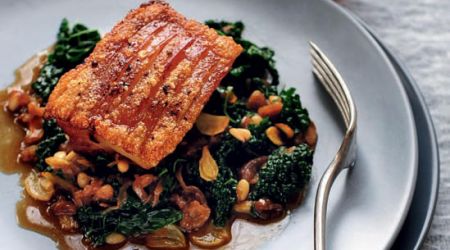Cavolo nero
It’s easy to see why Italian cooks love this kale family member, says Rosemary Barron
What’s in a name? Quite a lot, where cavolo nero is concerned. First, there’s the appetite-inducing attractiveness of it, the glamorous-sounding Italian name suggesting a delicious product of the Mediterranean. Then there’s a faint hint of something exotic, a food for the more adventurous cooks and gardeners among us. But when cavolo nero is translated into English, its name – black cabbage – causes this wonderful, nutrient-packed, dark-leafed vegetable to lose some of its allure, especially for those who dislike cabbage or have a vivid imagination. This would be a mistake, for cavolo nero is neither a cabbage (though it’s a member of the same botanical family), nor black (though nearly so), and it’s a very good food that has the added bonus of being fairly easy to grow.
Cavolo nero is in fact a kale (brassica oleracea var. acephala), known in the English-speaking world as Tuscan, blackleaf, dinosaur or Lacinato kale, and nero di toscano or cavolo toscano in Italy. Its cultivar heritage dates from 19th-century Tuscany and possibly at least three centuries earlier in Campania, although its origins are in the same huge and diverse botanical family (brassica, or mustard) that contains some of the first plants ever to have been cultivated. The descendents of one of this family’s sub-species – brassica oleracea, or wild cabbage – were highly valued in European antiquity by Greeks, Romans and Celts, and in Asia by the Chinese and Indians. These early cultivars have given rise over the centuries to many newer varieties including kale, cabbage, brussels sprouts, kohlrabi, cauliflower and broccoli.
Kale (kail in Scotland, cole or colewort in old English) is native to the coastal cliffs of southern England as well as to the Mediterranean and Adriatic coasts of Spain, Italy and Greece. Its name is derived from the Greek word caulos, or stem, as its loose, wrinkled, dark-green leaves grow from a heartless base. Although similar in flavour to cabbage, kale is the more primitive family member of the two, and a staple of country people throughout Europe until the end of the middle ages, when headed cabbages were bred. It is also hardier, and can withstand growing conditions that destroy the more delicate cabbage, thus ensuring its continuing popularity and many new cultivars.
Cavolo nero’s tall, almost blue-black leaves are a beautiful sight in a winter garden. This elegant perennial comes into season in October, but only develops its deeply crinkled, sweetest, most tender leaves after the first frost. Although one of the least hardy of the cultivated kales, as its Mediterranean origins suggest, cavolo nero can easily withstand our normal winter conditions, even a deep layer of snow that would make other brassicas keel over. It is immune too to most of the problems that beset other brassicas such as the white cabbage butterfly (and ensuing caterpillars), and is of little interest to pesky pigeons. It’s best, however, to plant it in a well-drained, compost-rich spot, and preferably one that benefits from winter sun. For the faster cavolo nero grows, the better it will taste.
In Tuscan markets, cavolo nero is sold as a whole head or bundle of leaves from early winter until the beginning of spring. Sometimes it’s called cavolo palmizio or cavolo a penna in an appreciative nod to its appearance (‘like a palm leaf’) or to the pasta it transforms into a fine dish. Tuscan and Florentine cooks will tell you that its robust texture and flavour makes it the ideal ingredient for hearty soups, especially ribollita toscana, a bean soup that tastes even better reheated the next day, thickened with bread, and drizzled with olive oil. Its strong character is a welcome addition, too, to slow-cooked winter dishes of pork, venison or pulses, and enlivens risotto and frittata. By happy coincidence, the new-season extra virgin olive oils appear in Tuscan markets at the same time as cavolo nero and their peppery, grassy flavour is the perfect foil for the earthy richness of the greens. A simple way to cook young leaves: strip the green from the ribs, cut into 3cm ribbons, blanch briefly in boiling water and drain well. Warm olive oil in a heavy sauté pan, add greens and a little chopped garlic and cook, tossing the greens, for five minutes. Season generously, and serve immediately, with sautéed potatoes, roast meats, fried fish or pasta. More olive oil poured over the cooked greens will improve their flavour, as too does a bit of chilli. Other strong flavours such as pancetta or anchovies meld beautifully with the tangy greens.
Cavolo nero’s popularity in Britain can be traced to that great ambassador for Italian cooking, The River Café. Talented chefs who have passed through its kitchens in the past 30 years now include it in their own repertoires – young greens in winter salads, older ones in colourful side dishes. For its profoundly satisfying ‘mineral’ flavour and sweet aftertaste is one that sits easily with some of our own favourite foods such as game, beef, offal and sausages. What’s more, high quantities of the vitamins A, K and C, significant amounts of the B vitamins and vitamin E, a very rich vegetable source of calcium, and a good source of vital minerals such as iron, magnesium, copper and potassium means that cavolo nero is indeed a superfood. ‘Black cabbage’ has never sounded so good.

Recipes
Get Premium access to all the latest content online
Subscribe and view full print editions online... Subscribe





